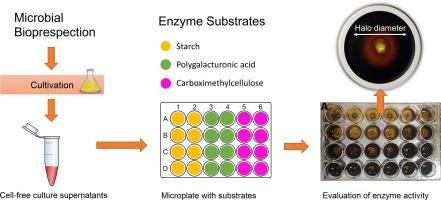Journal of Microbiological Methods ( IF 1.7 ) Pub Date : 2020-05-21 , DOI: 10.1016/j.mimet.2020.105948 Athayde Neves Junior 1 , Veronica da Silva Cardoso 1 , Felipe Raposo Passos Mansoldo 1 , Sabrina Martins Lage Cedrola 1 , Maria Cristina P P Reis Mansur 1 , Mateus Gomes Godoy 2 , Alane Beatriz Vermelho 1

|
This article presents a new qualitative method to detect enzyme activity replacing the conventional Agar-Petri dishes. This new method is a simple rapid and low-cost technique that uses 24-well microplates. The detection of hydrolases producing microorganisms in bioprospecting studies by qualitative methods is time consuming, costly and requires a large quantity of strains or enzymatic extracts. Tests with different substrate concentrations (0 to 20 g/L) in agar solution for the enzymatic hydrolysis analysis were performed to determine the best substrate concentrations in 24-well microplates. Other quantitative and analytical methods, such as enzymatic assays and thin layer chromatography, were performed to validate this new method and to compare the relationship between enzymatic activity and substrate degradation. Statistically relevant results were observed for amylase, endoglucanase and polygalacturonase enzymes, even when there was a low substrate concentration in agar, where the halo diameter was high. The results also indicated that the concentrations for efficient enzyme index measurements were 4 g/L carboxymethylcellulose for endoglucanase detection and 8 g/L for amylase and polygalacturonase assays. The results were presented according to the traditional methods for detection of enzymatic activity. This new method can be used as a general test for the detection of important industrial hydrolases. It is a faster and less costly alternative for screening microbial enzyme producing microorganisms and is useful for studying the production of microbial enzymes under different growing conditions.
中文翻译:

用于细胞外水解酶检测的微孔板检测。
本文提出了一种新的定性方法来检测酶的活性,取代了传统的Agar-Petri皿。这种新方法是使用24孔微孔板的简单快速且低成本的技术。在生物勘探研究中通过定性方法检测产生水解酶的微生物是费时,昂贵的,并且需要大量的菌株或酶提取物。进行琼脂溶液中不同底物浓度(0至20 g / L)的酶水解试验,以确定24孔微孔板中最佳底物浓度。进行了其他定量和分析方法,例如酶促测定和薄层色谱法,以验证该新方法并比较酶促活性和底物降解之间的关系。对于淀粉酶,内切葡聚糖酶和聚半乳糖醛酸酶,即使在晕圈直径较大的琼脂中底物浓度较低时,也观察到统计学上相关的结果。结果还表明,用于有效酶指数测量的浓度对于内切葡聚糖酶检测为4 g / L羧甲基纤维素,对于淀粉酶和聚半乳糖醛酸酶测定为8 g / L。结果是根据传统的酶活性检测方法给出的。此新方法可以用作检测重要工业水解酶的常规测试。它是筛选产生微生物酶的微生物的一种更快且成本更低的替代方法,可用于研究不同生长条件下微生物酶的产生。内切葡聚糖酶和聚半乳糖醛酸酶,即使琼脂中的底物浓度较低,晕圈直径也很高。结果还表明,用于有效酶指数测量的浓度对于内切葡聚糖酶检测为4 g / L羧甲基纤维素,对于淀粉酶和聚半乳糖醛酸酶测定为8 g / L。根据检测酶活性的传统方法给出了结果。此新方法可以用作检测重要工业水解酶的常规测试。它是筛选产生微生物酶的微生物的一种更快且成本更低的替代方法,可用于研究不同生长条件下微生物酶的产生。内切葡聚糖酶和聚半乳糖醛酸酶,即使琼脂中的底物浓度较低,晕圈直径也很高。结果还表明,用于有效酶指数测量的浓度对于内切葡聚糖酶检测为4 g / L羧甲基纤维素,对于淀粉酶和聚半乳糖醛酸酶测定为8 g / L。根据检测酶活性的传统方法给出了结果。此新方法可以用作检测重要工业水解酶的常规测试。它是筛选产生微生物酶的微生物的一种更快且成本更低的替代方法,可用于研究不同生长条件下微生物酶的产生。结果还表明,用于有效酶指数测量的浓度对于内切葡聚糖酶检测为4 g / L羧甲基纤维素,对于淀粉酶和聚半乳糖醛酸酶测定为8 g / L。根据检测酶活性的传统方法给出了结果。此新方法可以用作检测重要工业水解酶的常规测试。它是筛选产生微生物酶的微生物的一种更快且成本更低的替代方法,可用于研究不同生长条件下微生物酶的产生。结果还表明,用于有效酶指数测量的浓度对于内切葡聚糖酶检测为4 g / L羧甲基纤维素,对于淀粉酶和聚半乳糖醛酸酶测定为8 g / L。根据检测酶活性的传统方法给出了结果。这种新方法可以用作检测重要工业水解酶的常规测试。它是筛选产生微生物酶的微生物的一种更快且成本更低的替代方法,可用于研究不同生长条件下微生物酶的产生。根据检测酶活性的传统方法给出了结果。此新方法可以用作检测重要工业水解酶的常规测试。它是筛选产生微生物酶的微生物的一种更快且成本更低的替代方法,可用于研究不同生长条件下微生物酶的产生。结果是根据传统的酶活性检测方法给出的。这种新方法可以用作检测重要工业水解酶的常规测试。它是筛选产生微生物酶的微生物的一种更快且成本更低的替代方法,可用于研究不同生长条件下微生物酶的产生。











































 京公网安备 11010802027423号
京公网安备 11010802027423号